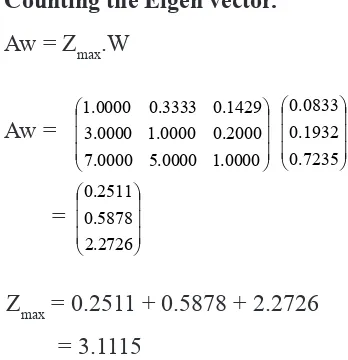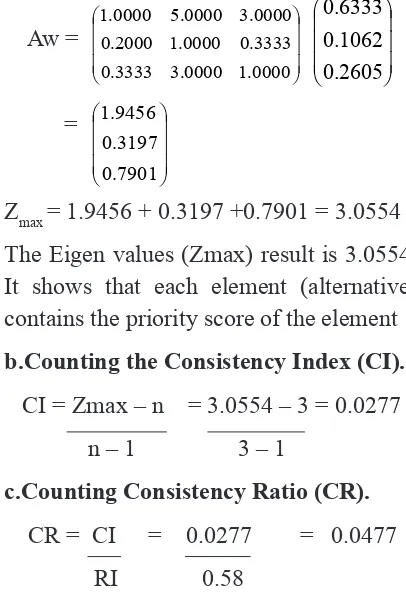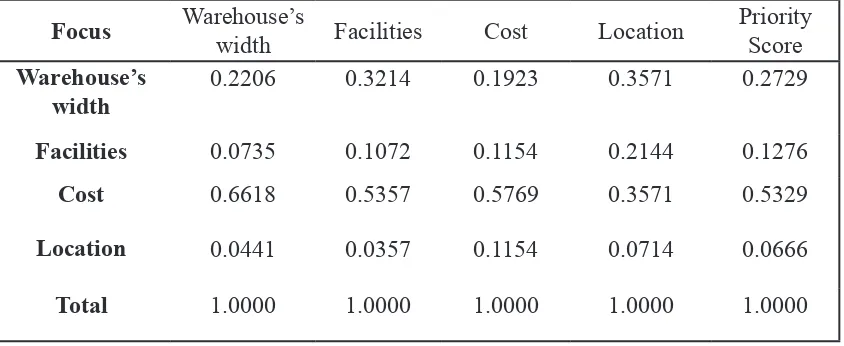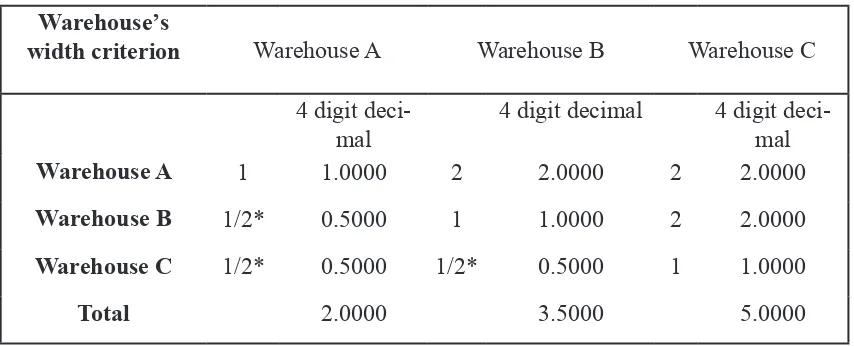Warehouse Selection for Storage of Finished Goods
Sarinah Sihombing STMT Trisakti stmt@indosat.net.id yoritupang@yahoo.com
Gires Firera STMT Trisakti stmt@indosat.net.id
ABSTRACT
In selecting a warehouse for storage of finished goods, from qualitative and quantitative data, aggregate value was obtained as a requirement to make choices and determine
costs.
Keyword: logistic, warehouse, analysis hierarchy process (AHP)
Introduction
Currently, almost all manufacturing companies have a warehouse, which gener
-ally serves as a temporary storage of goods
in each stage of the logistics process.
PT. Frisian Flag Indonesia (FFI) is a
manufacturing company that produces
healthy drinks such as powder and liquid milk with various other sub-products. In its operational activities, the FFI must al
-ways maintain the quality of the products it produces, especially the storage activities in the warehouse. The warehouse used for
temporary storage of the products as well as
a warehouse and distribution center is man
-aged by PT. YCH Indonesia. In addition to insufficient storage location, FFI also pays
attention to the hygiene or sterilization of
the warehouse environment and facilities that will be used to store all the finished products. It is being considered because the nature of the products requires special
treatment.
With the increasing number of new
products, followed by the addition of prod
-uct inventory in order to win the competi
-tion, FFI must be able to store the finished
products in a larger scale at the central
warehouse. However, due to the increase of additional inventory in the warehouse, FFI is looking for a new warehouse that can accommodate inventory with larger scale, better quality, and at a competitive cost.
Besides in Jakarta, FFI has other ware
-houses in other cities like in Surabaya, Se
-marang and Medan. It is aimed to make equal distributions of the product to be spread all over Indonesia. Of course, all the determinations and decisions on making warehousing services should be based on defined criteria.
This research used qualitative and quan
-titative data. Qualitative data is used for non-statistical analysis. Meanwhile, quan
-gistics managerss and the secondary data is
obtained from other parties related to the
research.
The measurement of the answer is based on Analytical Hierarchy Process method (AHP).
Analytical Hierarchy Process (AHP) is a systematic decision making method which was introduced by Thomas L. Saaty
during 1971-1975 when he was in Wharton
School. It is used if there are various crite
-ria of the decision making. There are some principals that need to be understood from the AHP method, namely: decomposition, comperative judgment, synthesis of prior
-ity, dan logical consistensy.
Furthermore, AHP also has a special concern about the deviations of consisten
-cy in the pairwise comparison matrix. First, the decision makers make a scoring on the relative importance between two elements qualitatively of “vertical (ci)” element with “horizontal (cj)” element in the pairwise
comparison matrix using the following for-mula: (Saaty, 1994).
Results and Disscusion
a. Rating the relative importance of two elements
...(1)
a = Pairwise Comparison matrix.
ci,cj,...,n = Elements (criteria) on pairwise
comparison matrix of a level in a hierar -chy.
wi,wj,...,wn= The relative importance score
between the two elements of the
matrix of pairwise comparison
based on the interpretation of paired comparisons (attachment
IV appendix B.1)
After scoring the relative importance be
-tween elements, the inverse value is carried out to obtain the inverse score or reciprocal axiom, using the following formula:
b.Reciprocal axiom
aij = 1
aij ...(2)
a = Pairwise Comparison matrix
c
i,cj,...,n = Elements (criteria) on pairwise comparison matrix of a level in a hierarchy. The scoring was
performed to measure the con-sistency of the results of the
relative importance between elements scoring quantitatively. The results of these scoring is said to be perfect or consistent if it satisfies the following for -mula:
c. Consistancy Scoring
....(3)
a = Pairwise Comparison matrix.
n or z = The total of relative importance be
-tween elements (ci, cj, ck, ..., n) scoring and the inverse value (re
-ciprocal axiom) in each column of the Pairwise Comparison matrix or the Eigen values
w = priority score of pairwise comparison matrix.
This assessment was conducted to determine the validity of the priority score of pairwise comparison matrix. Thus obtained Zmax or Eigen value that meets the priority score in the pairwise comparison matrix. The
consistency of the indicators measured aij = wi/wj
through the Consistency Index (CI)
formulated as follow:
1. Counting the Consistensy Index value
...(4)
CI = Consistensy Index.
Zmax = the maximum Eigen value of the
pairwise comparison matrix n = the no of elements of pairwise
comparison matrix
AHP measures the entire consistency value using the Consistency Ratio (CR) as defined:
2.Counting the Consistency Ratio (CR)
...(5) CR = Consistensy Index (CI)
Random Consistensy Index *) RI score is the score of the Random Index issued by Oarkridge Laboratory in the form shown in table 1. n is the number of criteria
contained in the pairwise comparison ma-trix.
Determination of the Criteria of Each Warehouse Selection Priority
The decision makers should consider the following items before making the deci -sion:
1. Warehouse’s width; this is the first crite
-ria should be considered.
2. Fasilities; assessed only on the avail
-ability of pallets owned by the suppliers
and types of storage facilities on each
al-ternative which are racking and stacking blocks (bulk)
3. cost; assessed from the rental and ship -ping costs from the factory to the ware-house as well as the cost per pallet.
4. Location; assessed from the distance and travel time between factories and ware -houses
What being analyzed in this case is three warehouses with their own criteria, namely warehouse A, B, and C.
Table 2 is pairwise comparison matrix of the criteria of warehouse selection equiped with the relative importance score between elements and values of axioms Reciprocal based on the results of relative importance score between elements of decision mak
-ers value.
The table is the initial assessment done by comparing the vertical elements with
horizontal elements.
1. Warehouse’s width is more important
than facilities so it is weighted 3.
2. Cost is more important than warehouse’s
width so it is weighted 3.
3. Warehouse’s width is more important
than location so it is weighted 5.
4. Cost is more important than facilities so
it is weighted 5.
5. Facilities is more important than loca
-tion so it is weighted 3.
6. Cost is more important than location so it is weighted 5.
The matrix gave result to the total value for each column that is Eigen value (Z) of
the pairwise comparison matrix. Column
that has the smallest Eigen value will be
the highest priority score to the normalized matrix.
Table 3 refers to normalized matrix which was gained from the division of the pairwise comparison matrix and the Eigen value of each column. It shows the results of the perfect normalization calculations, as the total value of each column is 1.0000,
CI = Zmax – n
The comparison between alternative warehouses and warehouses’ width criterion
The first criterion is to perform pairwise comparisons for each alternative of warehouse’s width criterion. Filling the relative importance score of each alternative
against the warehouse’s width criterion is
done by using the result of the interviews done to the logistics managers, as seen on table 4.
The table is the initial assessment done by comparing the vertical elements with
horizontal elements.
a. Alternative Warehouse B is more impor
-tant than alternative Warehouse A, so it is weighted 3.
b. Alternative Warehouse C is much more important than alternative Warehouse A
so it is weighted 7.
c. Alternative Warehouse C is more impor
-tant than alternative Warehouse B so it is
weighted 5.
The matrix gave result to the total value for each column that is Eigen value (Z)
of the pairwise comparison matrix of the
warehouse’s width. Next is to make the normalized matrix as shown in table 5.
Table 5 refers to normalized matrix which was gained from the division of the
pairwise comparison matrix of warehouse’s
width criterion and the Eigen value of each
column. It shows the results of the perfect
normalization calculations, as the total val
-ue of each column is 1.0000. It also shows
the priority scores for each column.
After getting the priority score, the next is to test the consistency of the relative im
-portance assessment between elements by setting the value of Consistency Ratio (CR)
as well as the priority scores for each cri-terion
After getting the priority score, the next
is to test the consistency of the results of
relative importance score between elements by setting the value of Consistency Ratio (CR) through the following steps:
1. Counting the Eigen Vector Score.
Aw = Zmax.w It shows that each element (criterion)
contains the priority score of the ele-ment.
2.Counting the Consistency Index (CI).
CI = Zmax – n = 4.2847 – 4 n – 1 4 − 1
= 0.0949
3.Counting the Consistency Ratio (CR).
CR = CI = 0.0949 = 0.1055 RI 0,90
n is criteria compared. Based on table 1 RI
score for n = 4 is 0.90
The CR value gained from the calculation above is 0.1055. Because CR ≤ 0.10 then, there is no need to do the assessment revi
-sion because the priority score of each al
-ternative is consistent and valid
Determination of Alternative Priority toward Each Criterion
through the following steps: a. Counting the Eigen vector.
Aw = Zmax.W tains the priority score of the element. b.Counting Consistensy Index (CI).
CI = Zmax – n = 3.1115 – 3 = 0.0557 n – 1 3 – 1
c.Counting the Consistensy Ratio (CR).
CR = CI = 0.0557 = 0.0961 RI 0.58
n is criteria compared. Based on table 1 RI
score for n = 3 is 0.58
The CR value gained from the calculation above is 0.0961. Because CR ≤ 0.10 then, there is no need to do the assessment revi
-sion because the priority score of each al
-ternative is consistent and valid.
The Comparison between Alternative Warehouses and Facilities Criterion
The next process is to perform pairwise comparisons for each alternative against the facilities criterion. Filling the relative im
-portance score of each alternative against the facilities criterion is done by using the result of the interviews done to the logis
-tics managers like the steps taken before as shown in the matrix of table 6.
The matrix gave result to the total value for each column that is Eigen value (Z) of the
pairwise comparison matrix of the
facili-ties. Next is to make the normalized matrix as shown in table 7.
Table 7 refers to normalized matrix which was gained from the division of the pair -wise comparison matrix of facilities
crite-rion and the Eigen value of each column. It
shows the results of the perfect
normaliza-tion calculanormaliza-tions, as the total value of each column is 1.0000. It also shows the priority
scores for each column
After getting the priority score, the next is to test the consistency of the relative im
-portance assessment between elements by setting the value of Consistency Ratio (CR)
through the following steps: a.Counting the Eigen vector.
Aw = Zmax .w
Aw =
=
Zmax =1.5095 +0.9524+0.5988 = 3.0607 The Eigen values (Zmax) result is 3.0607. It shows that each element (alternative)
contains the priority score of the element. b.Counting the Consistency Index (CI).
CI = Zmax – n = 3.0607 – 3 = 0.0304 n – 1 3 – 1
c.Counting the Consistency Ratio (CR).
CR = CI = 0.0304 = 0.0523 RI 0.58
Based on the above calculation, the CR val
ue is 0.0523. Because CR ≤ 0.10 then, there is no need to do the assessment revision be
-cause the priority score of each alternative is consistent and valid.
The comparison between Alternative Warehouses and Cost Criterion
The next process is to perform pairwise comparisons for each alternative against the criteria of cost. Filling the relative impor
-tance score of each alternative against the Cost criterion is done by using the result of the interviews done to the logistics manag
-ers and resulted in the matrix of table 8: The matrix gave result to the total value for each column that is Eigen value (Z) of
the pairwise comparison matrix of the cost.
Next is to make the normalized matrix as shown in table 9.
Table 9 refers to normalized matrix which was gained from the division of the pair -wise comparison matrix of cost criterion
and the Eigen value of each alternative. After getting the priority score, the next is to test the consistency of the relative im
-portance assessment between elements by setting the value of Consistency Ratio (CR)
through the following steps: a. Counting eigen vector value.
Aw = Zmax .w
Aw =
=
Zmax = 0.8662 + 0.2223 + 2.0083 = 3.0967 The Eigen values (Zmax) result is 3.0967. It shows that each element (alternative)
contains the priority score of the element
b.Counting the Consistency Index (CI).
CI = Zmax – n = 3.0967 – 3 = 0.0484 n – 1 3 − 1
c.Counting the Consistency Ratio (CR).
CR = CI = 0.0484 = 0.0834 RI 0.58
Based on the above calculation, the CR val
-ue is 0.0834. Because CR ≤ 0.10 then, there is no need to do the assessment revision be
-cause the priority score of each alternative is consistent and valid.
The Comparison between Alternative Warehouses and Location Criterion
Then, the process followed by pairwise comparisons for each alternative against
the criterion of location using the result
of the interviews to the logistics managers
so we get a pairwise comparison matrix as
seen on table 10.
The matrix gave result to the total value for each column that is Eigen value (Z) of the
pairwise comparison matrix of the location.
Next is to make the normalized matrix as shown in table 11.
Table 11 refers to normalized matrix which was gained from the division of the
pairwise comparison matrix of location
cri-terion and the Eigen value of each column.
It shows the results of the perfect
normal-ization calculations, as the total value of each column is 1.0000. It also shows the
priority scores for each column.
After getting the priority score, the next is to test the consistency of the relative im
-portance assessment between elements by setting the value of Consistency Ratio (CR)
through the following steps:
a.Counting the Eigen Vector Score.
bigger than others that is 0.5829. Its width is 27,900 m2. It has 44,682 pallet capacity. Besides, it has Racking and Block Stacking (Bulk) facility, because it is located in Cibitung or 28 km from the factory, so it takes only one and half hour to get there.
The cost that needs to be prepared by the company is Rp 1,413,036,625 as the delivery cost from the factory to the warehouse is Rp 1,300,000 and the cost per pallet is Rp 31,625.
References
Arwani, A. 2009. Warehouse Check up.
Jakarta: PPM.
Heizer, J & Render, B. 2010. Manajemen
Operasi. Jakarta: Salemba Empat.
Yuzal, I. 1998. Gudang dan Pergudangan.
Jakarta: STMT Trisakti.
Gitosudarmo, I & Mulyono, A. 2000.
Manajemen Bisnis Logistik.
Yogyakarta: BPFE.
Warman, J. 2010. Manajemen Pergudangan.
Jakarta: PT. Pustaka Sinar Harapan. Rizal, K & Sari. 2004. Manajemen Logistik
Referensi dan Direktori. Jakarta: PPMI.
Marimin & Maghfiroh, N. 2010. Aplikasi
Teknik Pengambilan Keputusan
dalam Manajemen Rantai Pasok.
Bogor: IPB Press.
Indrajit, RE & Djokopranoto, R. 2006. Konsep Manajemen Supply Chain
Cara Baru Memandang Mata
Rantai Penyediaan Barang. Jakarta:
Grasindo.
Siagian, YM. 2005. Aplikasi Supply Chain
Management dalam Dunia Bisnis.
Jakarta: Grasindo. Aw =
=
Zmax = 1.9456 + 0.3197 +0.7901 = 3.0554 The Eigen values (Zmax) result is 3.0554. It shows that each element (alternative)
contains the priority score of the element b.Counting the Consistency Index (CI).
CI = Zmax – n = 3.0554 – 3 = 0.0277 n – 1 3 – 1
c.Counting Consistency Ratio (CR).
CR = CI = 0.0277 = 0.0477 RI 0.58
Based on the above calculation, the CR value is 0.0477. Because CR ≤ 0.10 then,
there is no need to do the assessment
revision.
The determination of Alternative Ware-house based on the Highest Aggregate Score.
The last process in the calculation of Analytical Hierarchy Process (AHP) is to
calculate the aggregate score of each
alter-native warehouse which was obtained by
multiplying the priority score of each
alter-native on all criteria with a priority score of each criterion. The alternative warehouse that has the highest aggregate value is chosen as a reference in decision-making. Table 12 shows the aggregate scoring.
Conclusion
Warehouse C was selected as the
storage of finished good at PT. Frisian Flag
Soebagio. 1995. Manajemen Logistik.
n 1 2 3 4 5 6 7 8 9 10
RI 0 0 0,58 0,90 1,12 1,24 1,32 1,41 1,45 1,49
Focus Warehouse’s width Facilities Cost Location
4 digit
decimal
4 digit
decimal
4 digit
decimal
4 digit
decimal Warehouse’s
width
1 1.0000 3 3.0000 1/3 0.3333 5 5.0000
Facilities 1/3* 0.3333 1 1.0000 1/5 0.2000 3 3.0000
Cost 3* 3.0000 5* 5.0000 1 1.0000 5 5.0000
Location 1/5* 0.2000 1/3* 0.3333 1/5* 0.2000 1 1.0000
Total 4.5333 9.3333 1.7333 14.000
Focus Warehouse’s
width Facilities Cost Location
Priority Score
Warehouse’s width
0.2206 0.3214 0.1923 0.3571 0.2729
Facilities 0.0735 0.1072 0.1154 0.2144 0.1276
Cost 0.6618 0.5357 0.5769 0.3571 0.5329
Location 0.0441 0.0357 0.1154 0.0714 0.0666
Total 1.0000 1.0000 1.0000 1.0000 1.0000
Appendices
Tabel. 1 Random Index (RI) Score
Table 2 Pairwise Comparison Matrix of Warehouse Selection Criteria
Table 3 Normalized Matrix Source: Sri Mulyono (2002)
Source: Processed interview result * = reverse score (axioms reciprocal)
Warehouse’s
width criterion Warehouse A Warehouse B Warehouse C
4 digit decimal 4 digit decimal 4 digit deci
-mal
Warehouse A 1 1.0000 1/3 0.3333 1/7 0.1429
Warehouse B 3* 3.0000 1 1,0000 1/5 0.2000
Warehouse C 7* 7.0000 5* 5.0000 1 1.0000
Total 11.0000 6.3333 1.3429
Table 4 Warehouse’s width Pairwise Comparison Matrix
Source: Processed Interview result
* = reverse score (axioms reciprocal)
Warehouse’s
width criterion Warehouse A Warehouse B Warehouse C Priority Score
Warehouse A 0.0909 0.0526 0.1064 0.0833
Warehouse B 0.2727 0.1579 0.1489 0.1932
Warehouse C 0.6364 0.7895 0.7447 0.7235
Total 1.0000 1.0000 1.0000 1.0000
Warehouse’s
width criterion Warehouse A Warehouse B Warehouse C
4 digit deci -mal
4 digit decimal 4 digit deci -mal
Warehouse A 1 1.0000 2 2.0000 2 2.0000
Warehouse B 1/2* 0.5000 1 1.0000 2 2.0000
Warehouse C 1/2* 0.5000 1/2* 0.5000 1 1.0000
Total 2.0000 3.5000 5.0000
Table 5 Normalized Matrix
Table 6 Facilities Pairwise Comparison Matrix Source: Processed Interview result
Source: Processed Interview result
Warehouse’s
width criterion Warehouse A Warehouse B Warehouse C
4 digit deci -mal
4 digit decimal 4 digit decimal
Warehouse A 1 1.0000 5 5.0000 1/3 0.3333
Warehouse B 1/5* 0.2000 1 1.0000 1/7 0.1429
Warehouse C 3* 3.0000 7* 7.0000 1 1.0000
Total 4.2000 13.0000 1.4762
Cost Criterion Warehouse A Warehouse B Warehouse C Priority Score
Warehouse A 0.2381 0.3846 0.2258 0.2828
Warehouse B 0.0476 0.0769 0.0968 0.0738
Warehouse C 0.7143 0.5385 0.6774 0.6434
Total 1.0000 1.0000 1.0000 1.0000
Table 8 Cost Pairwise Comparison Matrix
Table 9 Normalized Matrix Source: Processed Interview result
* = reverse score (axioms reciprocal)
Source: Processed Interview result
Facilities Criterion Warehouse A Warehouse B Warehouse C Priority Score
Warehouse A 0.5000 0.5714 0.4000 0.4905
Warehouse B 0.2500 0.2857 0.4000 0.3119
Warehouse C 0.2500 0.1429 0.2000 0.1976
Total 1.0000 1.0000 1.0000 1.0000
Table 7 Matriks Normalized
Warehouse’s
width criterion Warehouse A Warehouse B Warehouse C
4 digit deci -mal
4 digit decimal 4 digit decimal
Warehouse A 1 1.0000 5 5.0000 3 3.0000
Warehouse B 1/5* 0.2000 1 1.0000 1/3 0.3333
Warehouse C 1/3* 0.3333 3* 3.0000 1 1.0000
Total 1.5333 9.0000 4.3333
Location Criterion Warehouse A Warehouse B Warehouse C Priority Score
Warehouse A 0.6522 0.5556 0.6923 0.6333
Warehouse B 0.1304 0.1111 0.0769 0.1062
Warehouse C 0.2174 0.3333 0.2308 0.2605
Total 1.0000 1.0000 1.0000 1.0000
Warehouse’s
width Facilities Cost Location
Aggregate Value
0.2729 0.1276 0.5329 0.0667
Warehouse A 0.0833 0.4905 0.2828 0.6333 0.2783
Warehouse B 0.,1932 0.3119 0.0738 0.1062 0.1389
Warehouse C 0.7235 0.1976 0.6434 0.2605 0.5829
Table 10 Location Pairwise Comparison Matrix
Table 11 Normalized Matrix
Table 22 Final Scoring of Each Alternative Source: Processed Interview result
* = reverse score (axioms reciprocal)
Source: Processed Interview result





